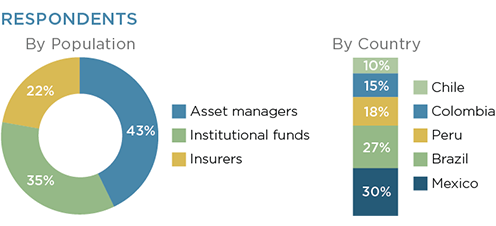Table of Contents
- 1.Executive Summary
- 2.Introduction
- 3.Drivers of Growth
- 4.ETFs Provide Critical International Exposure
- 5.Equity ETFs Enter the Mainstream
- 6.Big Increases Projected in Fixed Income
- 7.Smart Beta Draws a Crowd
- 8.Expanding Applications
- 9.ETFs Take Their Place in the Beta Toolbox
- 10.Increasing ETF Demand for Multi-Asset Strategies
- 11.Growing Comfort, Fewer Obstacles
- 12.iShares/BlackRock Is Top Latin American ETF Provider
- 13.Conclusion
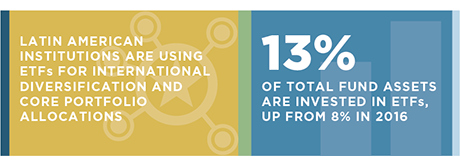
Executive Summary
Institutional investment in exchange-traded funds (ETFs) is growing rapidly in Latin America. Some of that growth can be attributed to a worldwide proliferation of ETFs that has made investors and regulators in every market more familiar and comfortable with their use in institutional portfolios. Latin American institutions in particular are stepping up their use of ETFs because the funds are helping them achieve specific and important goals. Among the factors contributing to ETF growth in Latin America:
- International Diversification: Latin American institutions need international exposure, and they see ETFs as one of the most efficient means to obtain it. Growing numbers of institutions are using ETFs domiciled in the United States, Ireland and continental Europe. Demand for international exposure will remain one of the biggest drivers of ETF demand in the coming year.
- Efficient (and Cheap) Beta Exposures: Latin American institutions are adopting ETFs as a core source of beta exposure alongside index mutual funds and derivatives. Relative to futures and swaps, institutions see ETFs as easier to understand and much easier to employ. Yet the utility of index ETFs is not limited to passive strategies. On the contrary, Latin American institutions are using the beta exposures provided by ETFs as key components of active management strategies.
- Expanding Portfolio Functions: Institutions that experimented with ETFs in past years have discovered that they are versatile tools. Investors are capitalizing on this flexibility by applying ETFs in a growing number of asset classes and in an expanding list of portfolio functions. Allocations to factor-based/smart beta ETFs are on the rise, and investors are increasingly using ETFs to meet specific environmental, social and governance (ESG) mandates. Institutions are also using the funds to replaces derivatives and individual securities. These applications are fueling a steady increase in ETF allocations among existing institutional users that will continue in 2018 and beyond.
- Broadening Use of Fixed-Income ETFs: Adoption of fixed-income ETFs continues to grow, with 45% of current investors in the funds planning to increase allocations in the coming year. But institutions are expanding their use beyond exposure to the asset class as a whole, with growing numbers of investors using fixed-income ETFs to diversify away from local or regional exposures to international fixed income.
- Innovation and Product Development: The worldwide boom in multi-asset strategies is stoking demand for ETFs among Latin American asset managers, many of which use ETFs as basic building blocks of their multi-strategy funds. At the same time, the roll out of new smart beta ETFs and other innovative ETF strategies is helping Latin American institutions meet essential goals such as income generation, volatility management and long-term outperformance.
- Increased Adoption of UCITS ETFs: The UCITS ETF market has grown to a total of $780 billion in assets at the end of 2017, fueled by demand from global investors—particularly in Latin America. For Latin American institutions, the UCITS ETF platform offers flexibility, improved portfolio and tax efficiency, and innovative, low-cost core options.
The results of the Greenwich Associates 2017 Latin American ETF Study suggest that the growth trend for ETFs could accelerate in the coming months. Of the 60 Latin American institutions participating in the study, more than half of current equity ETF investors plan to increase allocations in the coming year, as do 45% of fixed-income ETF investors.
Introduction
Across Latin America, institutional investments in ETFs are growing rapidly as current investors begin boosting allocations and applying ETFs to new asset classes and functions. Those institutions increased allocations to the funds to 13.1% of total assets in 2017 from 7.6% in 2016. More than 1 in 5 institutions now allocate over 20% of portfolio assets to ETFs.

Driving this growth is the increased usage and allocation of ETFs in asset classes beyond equities. For example, among the roughly 30% of institutions that invest in fixed-income ETFs, allocations to the funds increased to 6.8% of fixed-income assets in 2017, a 16% increase over 2016 levels.
“Using ETFs allows us to participate with general exposures, which we wouldn't have been able to obtain without using this type of instrument,” says the Head of Research and Fund Selection for a Peruvian institutional fund, explaining his firm’s expanding ETF use.
Moreover, institutions’ need for international exposures is fueling the expansion of ETF use across asset classes, including a dramatic increase year over year in commodities and REITs, both viewed as hedges against potential inflation.
Across all these asset classes, institutions are using ETFs in a broad and growing number of ways. From 2016 to 2017, Latin American institutions’ usage of ETFs increased in every one of the 10 portfolio functions addressed in the study—a list of that ranges from the narrowest tactical applications to the broadest strategic investment functions.
Latin American institutions are adopting ETFs as part of a general effort to address what investors in the region see as serious concerns for markets and their portfolios in the year ahead. Nearly half the institutions in the study see geopolitical risk as a potential threat to their portfolios in 2018, and nearly 45% rank related factors like market volatility and “unforeseen external factors” as concerns for the year ahead. As they search for attractive investment opportunities while also positioning their portfolios to protect against these possible risks, Latin American institutions are discovering that the flexibility and versatility of ETFs make valuable additions to their portfolios.
As issues that in the past served as impediments to institutional use of ETFs fall by the wayside, Greenwich Associates expects continued growth ahead. Institutions in the study report high levels of confidence in the construction, management, pricing, and liquidity of ETFs, and 80% of respondents say they have no concerns about the pace at which ETFs are growing. As more institutions gain experience with and knowledge about ETFs, investment committees and trustees will scale back internal restrictions on ETF investments.
External factors (such as regulations) will also contribute to growth. For example, 36% of Latin American insurance companies say regulatory reforms such as Europe’s MiFID II—which is already having an impact on institutional investors around the world—will cause them to increase their use of ETF
Altogether, more than half of Latin American institutions currently investing in equity ETFs plan to increase equity ETF allocations in the coming year. Only 3% plan cuts. Forty-five percent of fixed-income ETF investors expect to increase ETF allocations in the coming year. None of the institutions in the study plan to cut allocations to bond ETFs. These data suggest that the growth trend for ETFs could accelerate in 2018.
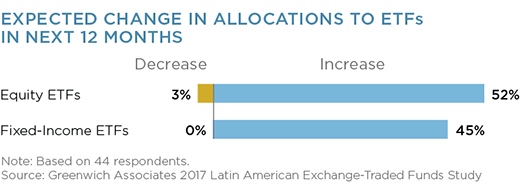
Drivers of Growth
The primary driver of ETF adoption in the Latin American institutional channel is the rapid growth of the funds throughout the portfolios of existing ETF investors. Every one of the fifty-two institutional ETF users participating in the study invests in equity ETFs. These institutions are adding ETFs to their equity portfolios at a rapid rate, often as a means of adding international exposures. This need is also fueling the steady, if gradual, increase in ETF allocations to fixed income.
ETFs are also gaining a sizable presence in asset classes beyond equity and fixed income. The share of institutions using ETFs in commodities increased to 21% in 2017 from just 5% in 2016, and ETF use in REITs grew to 12% from 3%. These increases likely indicate investor belief that ETFs can be used to protect portfolios against inflation, a growing concern in a rising interest-rate environment.
This progression mirrors the growth trend documented by Greenwich Associates among institutions in other markets in which ETF investment has followed a predictable path: Institutions start using ETFs in equities, and as these early adopters become more familiar with and knowledgeable about ETFs, they and other institutions in the market gain the confidence to adopt ETFs in fixed-income portfolios. Then gradually, they start to expand ETF holdings to other asset classes.
Institutions participating in the study explained why they are expanding their use of ETFs:
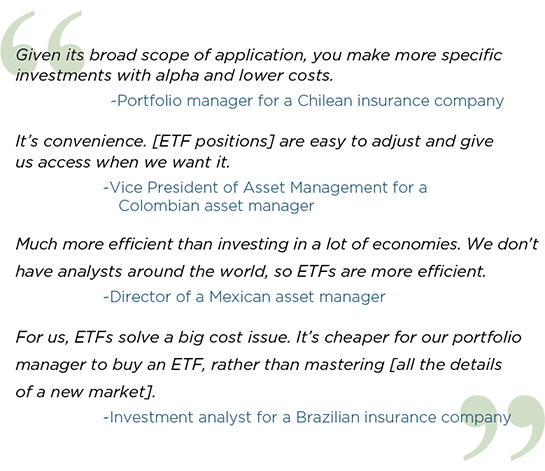
ETFs Provide Critical International Exposure
Consistent with global trends away from home-market biases, international diversification efforts on the part of Latin American institutions have been one of the key drivers of ETF growth over the past 12 months. While the share of institutions using ETFs in local Latin American markets was essentially stable from year to year at about 70%, the share of ETF investors using ETFs domiciled in the U.S. (NYSE, NASDAQ, etc.) increased to 63% from 58%. ETF use domiciled in the United Kingdom and Germany has also risen, up from 15% to 25% (London Stock Exchange) and from just 5% to 12% (Deutsche Borse).
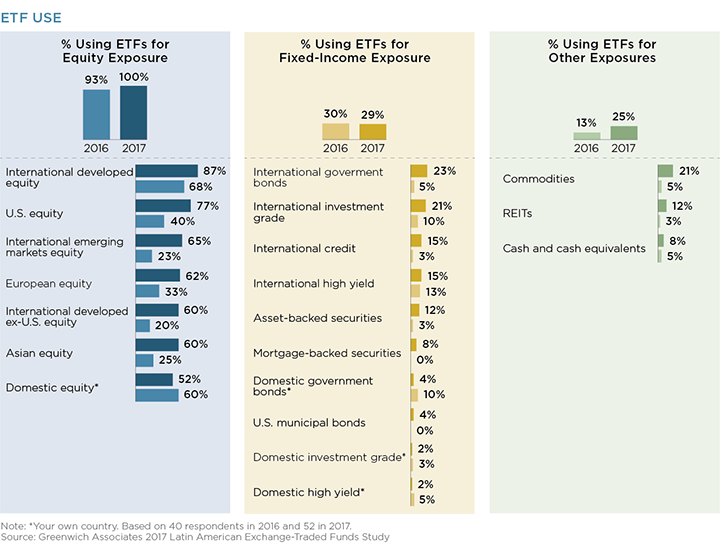
Over the same year-to-year period, the share of equity ETF investors using the funds in international developed equity jumped to 87% from just 68%. Even bigger increases were seen in the use of ETFs for U.S. equity (now at 77%), European equity (62%) and Asian equity (60%). The story is the same in fixed income. Almost a quarter of ETF investors in the study use ETFs in international government bonds, up from just 5% in 2016. The share of ETF investors using the funds in international investment grade more than doubled year on year to 21%.
The Director of Investments for a Mexican asset management firm summed up the comments of many of his Latin American peers when he explained why his fund is making more use of international ETFs: “We don't have analysts around the world, so an ETF is more efficient.”
An analyst for a Brazilian pension fund says his firm uses ETFs for international exposures because regulations limit direct cross-border investments for pension funds. The Head of Investments for a Brazilian institutional fund says his fund faces a similar situation, adding that an S&P 500 ETF provides a vehicle for U.S. exposure for institutions like his, which “don't have direct access to the American market.”
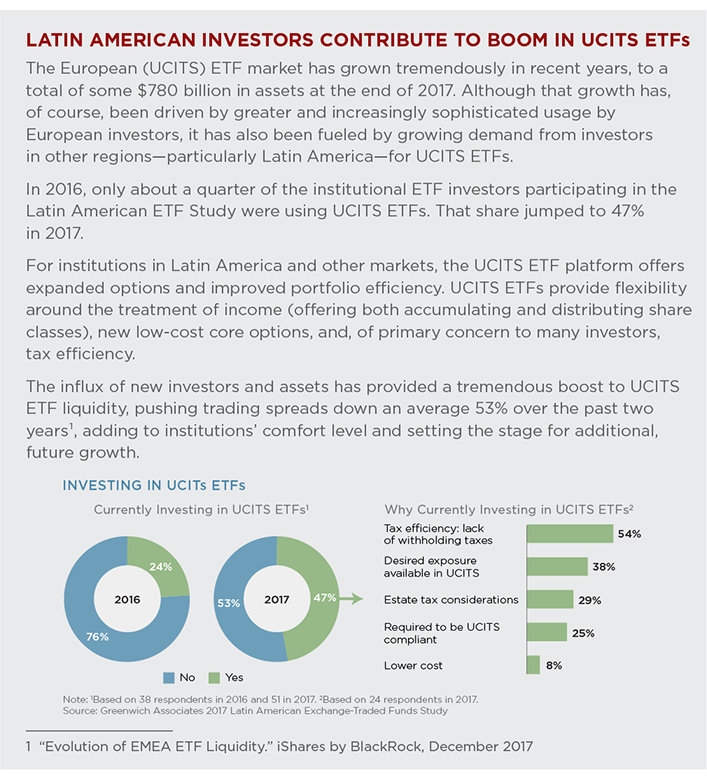
Equity ETFs Enter the Mainstream
Equity portfolios are ground zero for early-stage institutional investment in ETFs. As such, equity portfolios can be seen as an indicator of the future direction for ETF investment. In Latin America, those signals are pointing clearly in the direction of growth.

All of the 52 institutional ETF users participating in the study invest in equity ETFs. Of these, 52% plan to increase their allocations to equity ETFs in the year ahead, while only 3% plan to reduce allocations. Perhaps even more impressive is that among institutions planning an increase, a full 53% plan to boost allocations by more than 10%. Thirty-five percent plan increases in the 5% to 10% range.
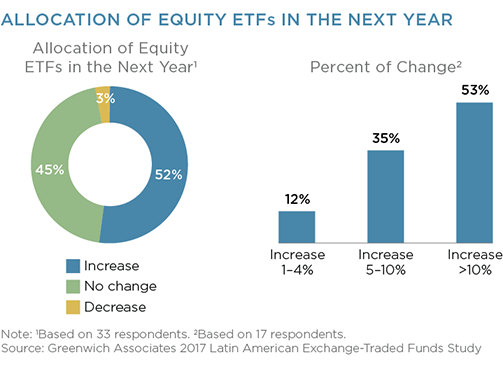
Adding to those bullish signals among current users is the fact that 60% of non-users say they are “somewhat likely” (30%) or “very likely” (30%) to start investing in equity ETFs in the next year.
New users are being attracted to equity ETFs because they are easy to use, liquid and provide efficient market access and a means of rapid execution to gain diversified exposures. “I use ETFs when I need quick and immediate exposure to a specific country,” says a trader for a Chilean insurance company. Among the other important benefits cited by study participants are single-trade diversification, transparency and attractive management fees.
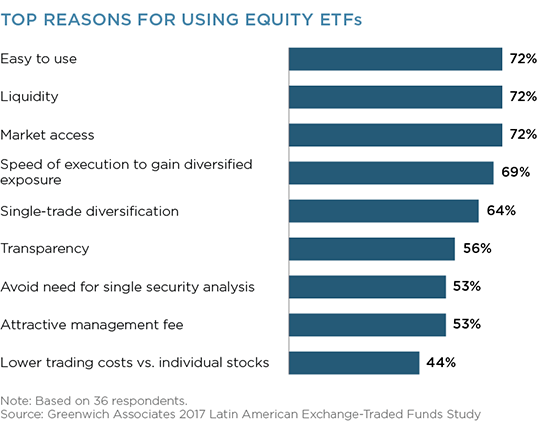
Big Increases Projected in Fixed Income
Although individual bonds still make up 83% of total fixed-income assets, allocations to bond ETFs are gradually increasing. Among Latin American institutions in the study, overall allocations to bond ETFs rose to approximately 7% in 2017, a nearly 17% increase over 2016 levels.
“We have mutual funds with different degrees of investment for fixed assets, but ETFs have more vehicles and offer greater diversification,” says a portfolio manager for a Peruvian asset management firm, explaining his firm’s growing use of fixed-income ETFs.
This growth appears on track to accelerate in 2018. Of the 45% of existing fixed-income ETF investors planning to increase allocations in the coming year, an impressive 40% expect to boost allocations by more than 10%. No institutions in the study plan to reduce these allocations.
Although most recent growth in fixed-income ETFs has been driven by current investors increasing allocations, assets from new investors are also contributing to this growth. Bond ETFs still represent a new and relatively novel vehicle for many Latin American institutions. Approximately 40% of study participants now using bond ETFs started investing in these funds within the past two years. Among non-users, approximately half say they are either “somewhat likely” (28%) or “very likely” (21%) to start using fixed-income ETFs in the year ahead. Among asset manager non-users, that share climbs to 70%.
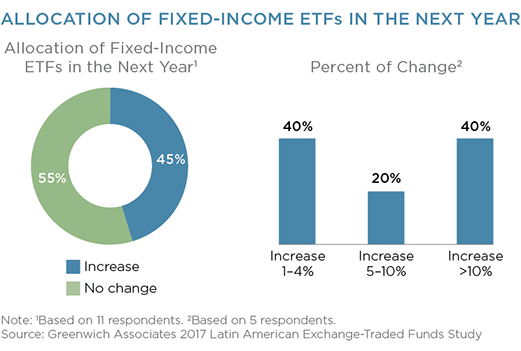
What’s attracting these investors? Institutions’ growing demand for international exposures to diversify fixed-income portfolios is playing a big role, as evidenced by the significant year-over-year increase in the use of ETFs in international government bond and international investment-grade credit strategies. Overall, institutions investing in fixedincome ETFs cite single-trade diversification and liquidity enhancement as top benefits, followed by quick access and low management fees.
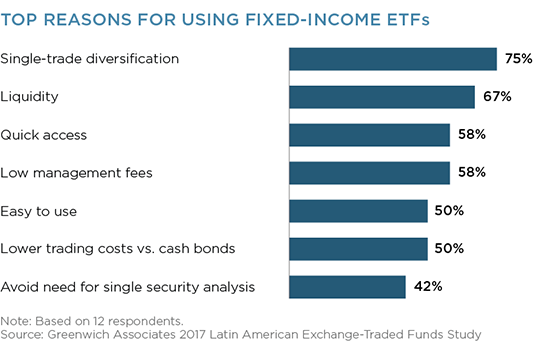
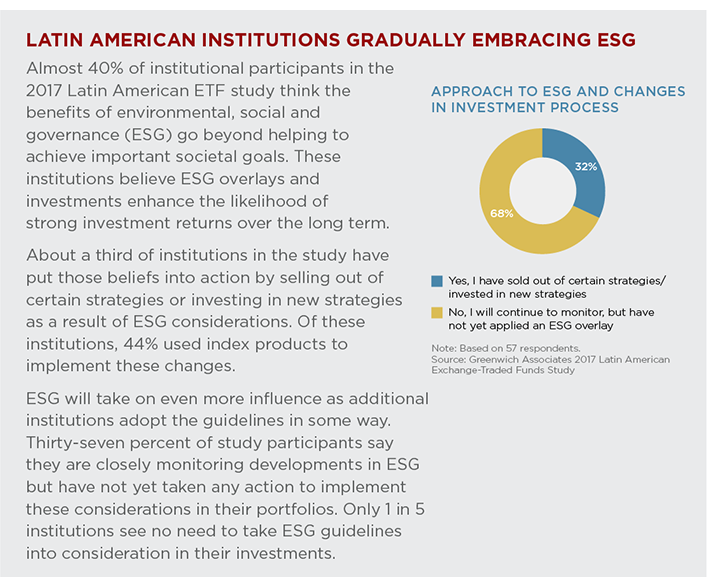
Smart Beta Draws a Crowd
Usage rates among Latin American institutions are on the upswing across a range of smart beta ETF strategies that investors are adopting to help achieve both short-term and long-term goals. Growth rates will accelerate in 2018, as institutions follow through with plans to increase allocations to factor-based/smart beta ETFs.
About half the institutions in the study use smart beta or factor ETFs. By far the most popular offerings in this category are minimum-volatility ETFs, which are used by three-quarters of active smart beta users. Yet the most notable year-over-year increase was the pickup in use of multi-factor ETFs, which increased to 63% of Latin American smart beta users in 2017 from just 20% in 2016. That shift was in step with a broader movement among investors around the world to multi-factor strategies, due to their potential to deliver more consistent and reliable performance.
Meanwhile, a pickup in the use of dividend/equity-income ETFs to 42% of smart beta investors in 2017 from 20% in 2016 reflects the current low-yield environment and investors’ search for income. An investment analyst for a Brazilian institutional fund says his firm faces a shortage of options in the local Brazilian market for a dividend portfolio it runs and thus, “ended up opting to add ETFs to supplement the portfolio.”
Approximately 80% of institutions investing in smart beta ETFs expect to increase their allocations to the funds in the coming year. That share reaches 87% among asset managers. Of institutions planning an increase, 80% plan to boost allocations by at least 5%, and 1 in 5 are planning increases in excess of 10%. Among this group, demand will be strongest for multi-factor ETFs, followed by minimum-volatility ETFs and sector smart beta ETFs. No institutions reported plans to cut allocations to smart beta.

A majority of Latin American institutions planning to increase smart beta ETF allocations are doing so because they have an investment view on one or more specific factors. Also contributing to the growth of these allocations is institutions’ increasing understanding of how smart beta ETFs work and growing comfort at using the funds in their portfolios.
Expanding Applications
Latin American institutions are embracing ETFs for use in new portfolio applications across asset classes. Around the world, most institutional investors first adopt ETFs for a single, limited task. That initial use is sometimes narrow and tactical, like managing a transition between asset managers—or sometimes broad and strategic, like achieving some desired core investment exposure. In either case, institutions that experiment with ETFs generally have positive experiences. As they discover the funds’ ease of use and flexibility, they typically find additional opportunities to use them in their portfolios, fueling an increase in both allocations and overall investment.
That process is now playing out in Latin America. In 2016, institutions here were using ETFs for two main purposes: portfolio completion and making tactical adjustments to portfolios, with smaller shares of institutions using ETFs for additional portfolio functions. Over the past year, however, institutions in large numbers have taken up ETFs in a series of applications, ranging from rebalancing and interim beta to transition management and cash equitization.
What’s more, institutions are integrating ETFs into functions most critical to their investment processes. For example, two-thirds of institutions in 2017 were using ETFs to obtain investment exposures in their core portfolio allocations, up from only 15% in 2016. Nearly 70% of institutions are using ETFs for international diversification of their portfolios (up from 30% in 2016), and the share of institutions using ETFs for risk management or overlay management jumped to approximately 30% in 2017 from just 5% the prior year.
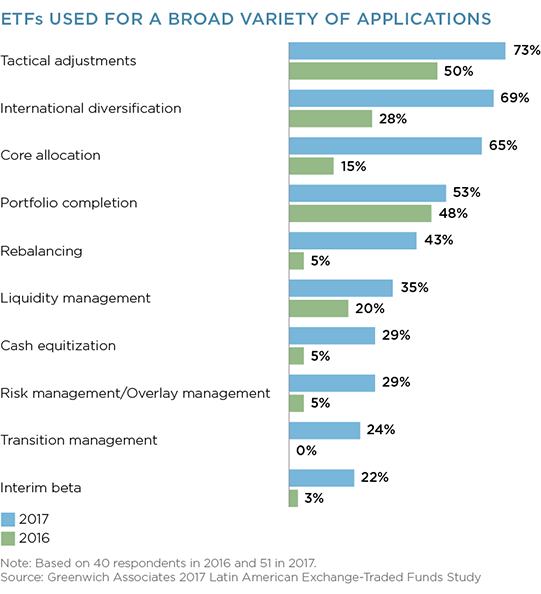
In fact, institutions in the study say close to two-thirds of their ETF assets are strategic, as opposed to tactical in nature. Several pension funds say they have adopted ETFs as part of broad liability management strategies. Institutions are also enlisting ETFs for a role that will remain essential in the current low-yield environment: income generation. Three-quarters of study respondents view ETFs as a source of income.
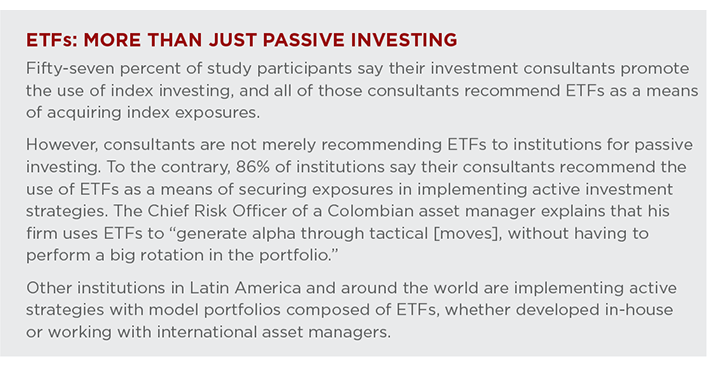
ETFs Take Their Place in the Beta Toolbox
ETFs are taking their place in Latin American institutional portfolios as a standard vehicle for obtaining beta exposures. Institutions’ primary means of accessing beta are through index/mutual funds (used for beta by 54% of study participants) and futures (used by 49%). As such, institutions have amassed large holdings of these vehicles in equity and fixed-income portfolios.
Over the past 12 months, however, 35% of study participants say ETFs have taken the place of some existing vehicles and positions. Among the vehicles being displaced by ETFs are active and index mutual funds, individual stocks and derivatives positions. Over the past 12 months, a full half of study participants who use futures to access beta have replaced derivatives positions with ETFs.
These moves are placing equity and fixed-income ETFs in institutional portfolios alongside these other vehicles as sources of beta. Most institutions adding ETFs into this mix did so for the operational simplicity provided by ETFs. Smaller shares of institutions made the shift to ETFs to lower rolling costs, enhance liquidity or to better comply with regulations.
The Head of Strategy for a Peruvian institutional fund described a regulatory change that forced his fund to liquidate a swap position. “We used an ETF and it gave us the same exposure,” he says.
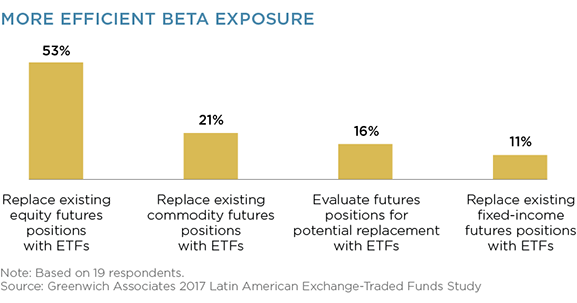
The data suggest institutions have spent considerable time evaluating the potential benefits and costs of integrating ETFs into portfolios as a source of beta, and now conclude that, at least in spots, it makes sense to replace other vehicles with ETFs. In our 2016 study, 42% of participants said they were “evaluating futures positions for potential replacement with ETFs,” compared to a quarter that were actively planning to swap out an equity futures position for an ETF. In 2017, only 16% of institutions place themselves in the “evaluation” stage, and 53% are actively planning to replace an existing equity futures position with ETFs in the coming year. (About 1 in 10 expect to switch out fixedincome futures positions in favor of ETFs.)
“ETFs are simply more efficient when it comes to liquidity,” says the Head of Strategy for a Colombian asset manager who has used ETFs in place of swaps and futures. “There are benchmarks that can be followed more easily with ETFs.”
One factor playing a role in these decisions is that, relative to derivatives, ETFs are easy to understand and employ. Institutions planning to switch to ETFs cite operational simplicity and ease of use as the primary drivers. Cost reduction also plays a central role and is cited as a reason by more than a third of institutions planning to make a switch from derivatives to ETFs in the next 12 months.
Increasing ETF Demand for Multi-Asset Strategies
Around the world, one consistent driver of ETF growth in the institutional channel for the past several years has been the proliferation of multiasset funds and the increased use by asset managers of ETFs as a building block for these funds.

Approximately half the asset managers participating in the Latin American ETF study employ ETFs in multi-asset funds. That share is up from approximately 40% in 2016. Also on the rise has been the share of total assets within these funds invested in ETFs, which has doubled to an average 31% over the past year.
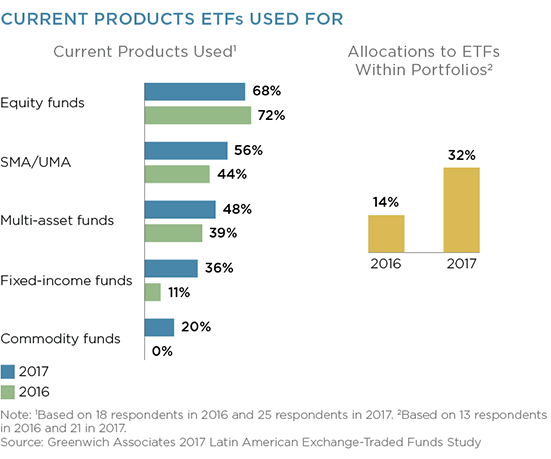
Even in the face of that growth, Greenwich Associates expects demand from multi-asset fund managers to continue and even expand in coming months and years. The reason: Multi-asset fund managers in Latin America are still allocating small shares of assets to ETFs relative to their counterparts in other markets. For example, in 2017, U.S. asset managers running multi-asset funds invested an average 62% of portfolio assets in ETFs. The fact that averages around the world have climbed to similar, higher levels indicates ample room for growth in Latin America.
Growing Comfort, Fewer Obstacles
Despite the proliferation of ETFs in Latin America and around the world, there are still obstacles limiting and even preventing investment on the part of some institutions.
Among institutions that do not invest in ETFs, it is often the fact that internal investment guidelines either prohibit or place significant restrictions on the use of ETFs, or that portfolio managers are required to obtain express permission from the organization before investing in an ETF. In its global research, Greenwich Associates has observed that many institutions relax or remove these rules as ETF use increases in the local institutional market, and investment peers are seen using ETFs safely and effectively.

Government regulations limiting institutional ETF investments by insurers or pension funds tend to follow a similar trajectory. This process of broader acceptance, which is already underway in Latin America, leads to increased adoption and bigger allocations.
Non-users without internal restrictions often cite concerns about ETF liquidity as a reason to abstain. This impediment to ETF use is also giving way to new market realities. Today, liquidity enhancement is one of the primary reasons institutions invest in equity and fixed-income ETFs. As holdouts see their peers not only seamlessly trading in and out of ETFs, but actually increasing portfolio liquidity relative to holdings of individual securities and other investment vehicles, concerns about liquidity are subsiding.
In fixed income, some Latin American ETF non-users say they have refrained from investing due to a lack of bond ETFs that align with needed exposures. That can be a real concern in Latin American portfolios that are mainly made up of domestic fixed income, with little international exposure. However, the combination of new ETF product rollouts and institutions seeking to diversify their portfolios with international assets should allow more Latin American institutions the opportunity to employ bond ETFs.
Together, these findings support a more general trend identified in our research. The primary obstacle to institutional adoption of ETFs has been a lack of understanding of and familiarity with the funds which, in some markets, have been widely perceived as most appropriate for retail investors. With ETFs now firmly established in the portfolios of institutions around the world, portfolio managers, investment committee members, regulators and other decision-makers are becoming comfortable with the funds, which are taking their place alongside other standard investment vehicles in these portfolios.
Improvements in technology platforms and a proliferation of ETF information sources has helped move this process forward. Almost 9 out of 10 institutions in the study say they have the tools they need to analyze and compare ETFs to other investment vehicles, such as futures and swaps. More than 90% of Latin American institutions name Bloomberg as the primary technology platform they use to buy ETFs—and institutions are almost universally satisfied with quality of that platform.
When it comes to collecting information about ETFs more generally, Latin American institutions tap a wide range of sources in addition to Bloomberg. For example, two-thirds of study participants cite sales teams from ETF issuers as important sources of information. Institutions also cite conferences, broker-dealers, in-house due diligence, and articles in third-party publications as sources of information on ETFs.
iShares/BlackRock Is Top Latin American ETF Provider
When it comes to selecting a specific ETF for investment, Latin American institutions first assess two primary factors: liquidity/trading volume and fund performance, including tracking error. Institutions also analyze a range of criteria including ETF domicile (U.S., UCITS, local jurisdiction), AUM, the quality of the fund company behind the fund, quality of service of that provider, expense ratio, and how well the fund matches their exposure needs.
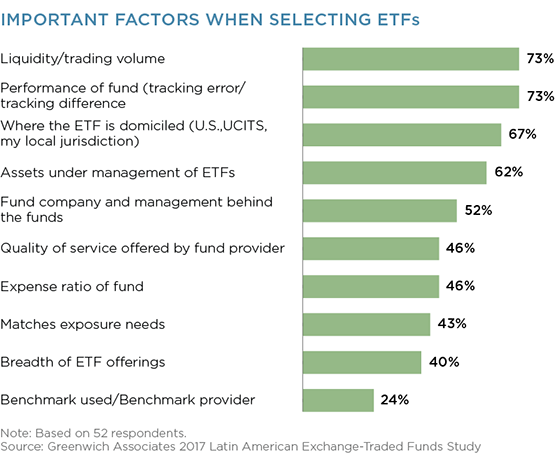
Based largely on those criteria, Latin American institutions have selected iShares/BlackRock as their ETF provider of choice. Ninety-eight percent of the institutions participating in the 2017 Latin American ETF Study use iShares/BlackRock as an ETF provider.
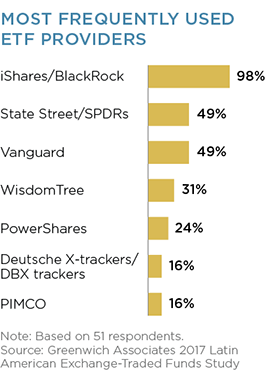
Study participants name iShares/BlackRock as the market’s best-in-class provider in all nine of the product and service categories assessed in this year’s study, including liquidity, range of products, exposures and domiciles, value for management fee, index tracking, use of institutional quality benchmarks, servicing platform, innovation, product transparency, and commitment to local markets (presence in the Latin American market).
Conclusion
Although institutional ETF investing is still in its early stages in Latin America, the results of Greenwich Associates second annual ETF study show that the funds have taken firm root in institutional portfolios and are advancing into a growing number of asset classes and portfolio applications in the region. Latin American institutions are adopting ETFs for such essential functions as obtaining core investment exposures, achieving international diversification and taking on beta exposures central to both passive and active management strategies. Having achieved more than satisfactory results with ETF investments to this point, Latin American institutions expect to accelerate their use and increase their allocations to ETFs in the months and years ahead.
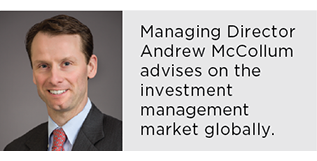
Greenwich Associates interviewed 60 Latin American institutional investors for its 2017 Latin American ETF Study, an increase from the 50 interviews conducted for our debut edition of this study in 2016. The 2017 research sample included a wide variety of institutional respondent types, but was composed mainly of asset managers (26), institutional funds (21) and insurance companies (13).
Thirty percent of study participants are located in Mexico, slightly more than a quarter are in Brazil, with the remainder divided among Peru, Colombia and Chile.
Approximately 50% of the institutions in the study have assets under management of $5 billion or more. Across all institutions in the study, 78% of assets are managed internally. Although that share is down from 88% among the research sample in 2016, relative to institutions in other markets/regions, these investors still manage sizable shares of their assets in-house. Insurers participating in the study manage a high of 86% of assets internally.
